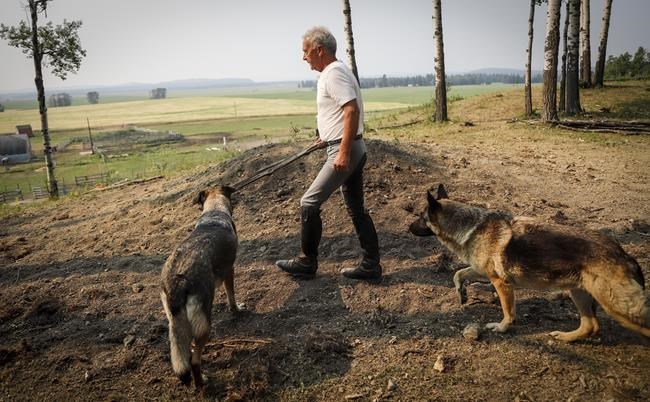SUNDRE, Alta. — A large dirt mound at the top of a green pasture in central Alberta is a reminder that tragedy can strike like lightning.
Two high-value horses being trained by Ian Tipton and his partner, Lisa Blanchard, died July 2, when a severe storm rolled in west of Sundre. High winds and 100 millimetres of rain fell in an hour, while multiple lightning strikes hit the house and nearby pasture.
When it was over, several horses charged up and down the pasture. Two of the 14 were gone.
"We've buried them near where they dropped," Tipton said in an interview with The Canadian Press.
"These two were pretty special and now they have a resting place overlooking everything."
There are numerous hoofprints in the dirt on the grave.
A number of horses in the herd have made the area their new resting place. Czar, an old, grey Andalusian, stood over his two fallen comrades — Cipato and Jacinto — for 24 hours after they died, Tipton said, and never strays far away.
It's something Tipton, who has been working with horses for the past 50 years, has never seen before.
"Those horses never left them, not for a minute. The little black guy was trying to wake them up and this grey horse stood over them and would not leave them until they were in the ground," he said.
"Any time I look up here, it never changes ... morning to night. They come back."
Blanchard said the horses who died were like family.
"We were just absolutely devastated, just sick with both the sense of personal loss — and professionally," she said.
Tipton Horsemanship is an education centre for classical horsemanship. Staff train horses, some of them Grand Prix quality, and have clients from around the world who want to ride them.
Cipato, an eight-year-old Friesian quarter-horse cross, was likely worth up to US$70,000, said Tipton, while Jacinto, a purebred Portuguese Lusitano, was worth roughly US$30,000. Both were insured.
"It certainly doesn't replace the value they are to us as family members," Tipton said.
David Phillips, a senior climatologist for Environment and Climate Change Canada, said July is the deadliest month for lightning strikes.
Canada records over two million strikes a year, or about one every three seconds. The most hit Ontario, followed by Alberta and Saskatchewan.
"The average temperature of a lightning flash is about 30,000 degrees Celsius and typically the voltage is about 150 times more powerful than the electric chair," Phillips said.
The most prevalent time for the storms to hit are at 1 p.m. and 6 p.m.
Very few lightning strikes are a direct hit. Phillips said most happen when lightning travels down an object then jumps, or when a current hits the ground then travels along the ground "and knocks you down."
Tipton said he is comforted knowing his two horses likely had a quick death.
"There was no suffering," Tipton said. "Both of those souls were perfectly happy and then boom they were gone."
This report by The Canadian Press was first published Aug. 9, 2021.
Bill Graveland, The Canadian Press
Note to readers: This is a corrected story. A previous version misspelled Blanchard.


